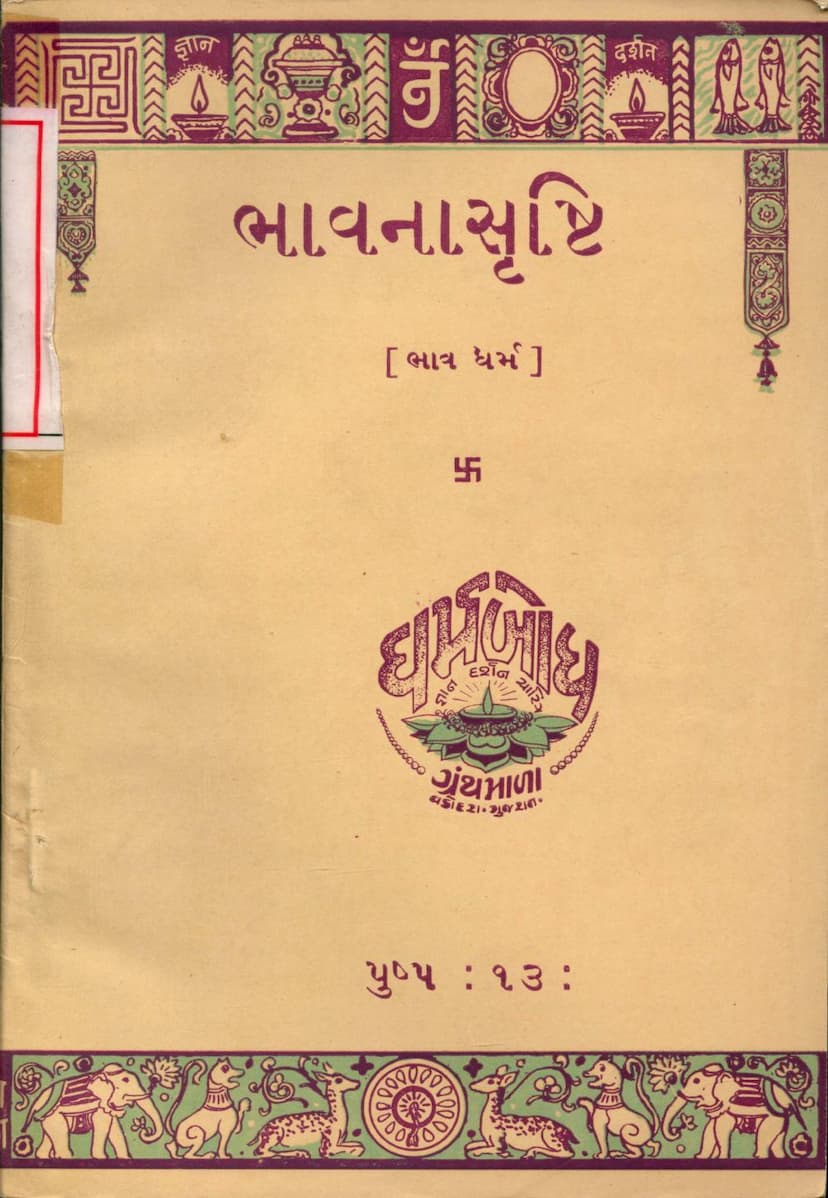Bhavna Srushti
Added to library: September 1, 2025

Summary
The book "Bhavna Srushti" (also known as "Bhav Dharma") by Dhirajlal Tokarshi Shah, published by Muktikamal Jain Mahagranthmala, is a comprehensive exploration of the importance of "Bhav" (feeling, intention, attitude) in Jainism. The book is part of the "Dharmbodh Granthmala" series.
The core message of the book is that Bhav is the most crucial element in spiritual practice and attainment, comparable to the significance of Mount Meru in mountains, Shatrunjaya in pilgrimage sites, or Ganga in rivers. It is described as a Kalpavriksha (wish-fulfilling tree), Kamadhenu (wish-fulfilling cow), and Chintamani jewel, capable of fulfilling all desires of those seeking liberation.
The book emphasizes that good intentions and a pure attitude are paramount, even more so than external actions or rituals. It uses various examples and narratives to illustrate this point:
- Vastupal's Devotion: The book highlights the prayers and aspirations of Minister Vastupal, a renowned philanthropist and builder of Jain temples, emphasizing his humility and his desire for continued service to Jainism in all his lives.
- Jirna Sheth's Devotion: The story of Jirna Sheth demonstrates how pure intention, even without the opportunity for grand actions, can lead to spiritual progress. Despite not being able to offer food to Lord Mahavir, his sincere Bhav earned him a celestial rebirth.
- The Deer's Devotion: The example of a deer that felt devotion towards Balabhadra Muni illustrates that even appreciating and supporting good deeds (anumo dana) with pure intention can yield significant spiritual merit, leading to rebirth in a celestial realm.
- Chandarudraacharya and His New Disciple: This narrative showcases a dramatic transformation brought about by the sincere and patient Bhav of a new disciple, which ultimately leads to the enlightenment of his wrathful Guru, Chandarudraacharya.
The book delves into Twelve Bhavnas (Meditations) as a means to purify one's Bhav and progress spiritually:
- Anitya Bhavna (Impermanence): Reflecting on the impermanent nature of all things, including youth, health, wealth, and life itself.
- Asharan Bhavna (Helplessness): Contemplating that in times of suffering, old age, and death, one is alone and cannot be truly protected by worldly relations or possessions.
- Sansar Bhavna (Worldly Cycle): Understanding the sorrowful and ultimately meaningless nature of the cycle of birth, death, and rebirth.
- Ekatva Bhavna (Aloneness): Recognizing the soul's inherent aloneness in its journey, separate from all worldly attachments.
- Anyatva Bhavna (Otherness): Differentiating between the self (soul) and the non-self (body, possessions, relations).
- Ashuchi Bhavna (Impurity): Reflecting on the impure and decaying nature of the physical body.
- Asrava Bhavna (Influx of Karma): Understanding the causes (mind, speech, action, passions) that lead to the influx of karmas.
- Samvar Bhavna (Stoppage of Karma): Meditating on practices that prevent the influx of new karmas, such as right faith, vows, self-control, and the five samitis (carefulness).
- Nirjara Bhavna (Shedding of Karma): Contemplating austerities, penance, and spiritual practices that help in shedding accumulated karmas.
- Dharma Bhavna (Righteousness): Reflecting on the true nature and importance of Jain Dharma, including its four pillars: Dana (charity), Shila (virtue), Tapas (austerity), and Bhav (attitude).
- Lok Bhavna (The Universe): Meditating on the structure and nature of the Jain universe (Loka) and one's place within it.
- Bodhi Durlabha Bhavna (Rarity of Right Enlightenment): Reflecting on the extreme difficulty of attaining human birth and the opportunity for spiritual awakening that it presents.
The book further elaborates on the concept that good Bhav can purify even minimal actions, making them highly meritorious. It stresses that Bhav is the very soul of religious practice, while actions are merely the body. The text underscores that a sincere "Namaskar" (obeisance) with pure intention can lead to liberation. It also emphasizes that the true measure of any action, even in acts of violence committed by ascetics, is the underlying Bhav, not just the physical act.
The book concludes by urging readers to cultivate pure Bhav, practice the twelve Bhavnas, and engage in spiritual disciplines to achieve liberation, highlighting that true happiness lies in inner peace and spiritual realization, not in worldly possessions or status. It reiterates that only Dharma, cultivated with the right attitude, can provide lasting solace and liberation.